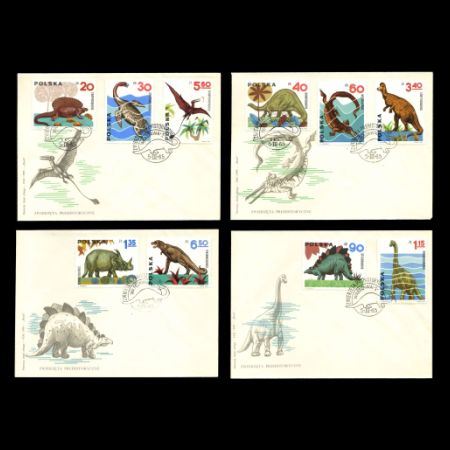Poland
1965
"Prehistoric animals"
| Issue Date |
05.03.1965 |
| ID |
Michel: 1570-1579
Scott: 1307-1316.
Stanley Gibbons: 1549-1558
Yvert: 1423-1432 UPU: N/A
Category: pR |
| Author |
A. Heindrich |
| Stamps in set |
10 |
| Value |
20 gr
Edaphosaurus,
30 gr Cryptoclidus,
40 gr Brontosaurus,
60 gr Mesosaurus,
90 gr Stegosaurus,
1.15 zl Brachiosaurus,
1.35 zl Styracosaurus,
3.40 zl Corythosaurus,
5.60 zl Rhamphorhynchus,
6.50 zl Tyrannosaurus |
| Size (width x height) |
39,5 X 51 mm / 51 x 39,5 mm |
| Layout |
10 stamps in sheet |
| Products |
FDC x 4 MS
x 10 |
| Paper |
coated paper |
| Perforation |
11x11,5 |
| Print Technique |
Offset |
| Printed by |
|
| Quantity |
20 gr (8,5. mln), 40 gr (8 mln), 90 gr
(5,5 mln), 1.35 zl
(4 mln), 6.50 al (1,41 mln) , 30 gr (6,5 mln), 60 gr (8 mln),
1.15 zl (4,5 mln), 3.40 z1 (3 mln), 5.60 al (1,41 mln) |
| Issuing Authority |
Poczta Polska |
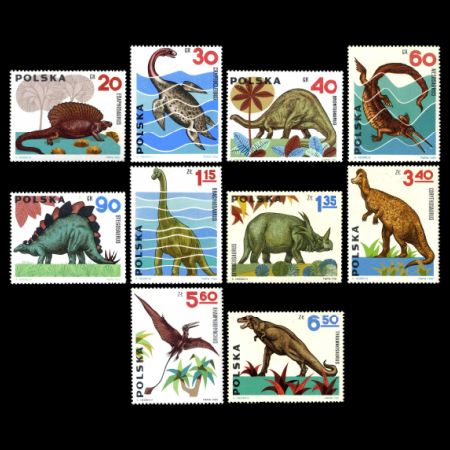
Paleontology is a science which due to its research of fossils and prints on them
introduces us in the fascinating and mysterious world of the
prehistorical flora and fauna.
The Polish Post having in mind the popularization of the results and discoveries of the paleontologists
issud in March 1965 the set of 10 stamps "Prehistorical Animals".
Stamps are based on pictures of Zdenek Burian, Czech painter and book illustrator whose work
played a central role in the development of palaeontological reconstructions during a remarkable
career spanning five decades.
Originally recognised only in his native Czechoslovakia, Burian's fame later spread to an international
audience, and a number of artists later attempted to emulate his style.
He was regarded by many as the most influential palaeo-artist of the modern era.
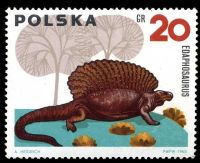 The
20 gr stamp represents a reptile EDAPHOSAURUS
living in the
Permian--Carboniferous period. The
20 gr stamp represents a reptile EDAPHOSAURUS
living in the
Permian--Carboniferous period.
|
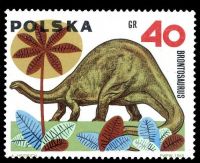 The
40 gr stamp acquaints us with the most popular
and known specimen of the dinosaur group BRONTOSAURUS. It
lived on the
marshes of North America in the Jarassic period some 150 million years
ago. It fed on plants. lis body was 18 meter long, weighed 20 ton,
period of growing up was 200 years. It was like all vegetable-feeding
giants, flegmatic and meek. Having no armour and being feebly teethed,
it had as only rescue againts the rapacious reptiles the Melit in the
water. The
40 gr stamp acquaints us with the most popular
and known specimen of the dinosaur group BRONTOSAURUS. It
lived on the
marshes of North America in the Jarassic period some 150 million years
ago. It fed on plants. lis body was 18 meter long, weighed 20 ton,
period of growing up was 200 years. It was like all vegetable-feeding
giants, flegmatic and meek. Having no armour and being feebly teethed,
it had as only rescue againts the rapacious reptiles the Melit in the
water. |
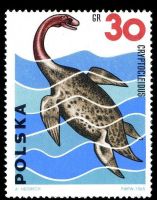 The
camivorous plesiosaur CRYPTOCLEIDUS
represented on the 30 gr stamp
lived fishing in the ocean in the Mesozoic era. Its body was flat, 5
meter long, covered with a smoth skin. It had four fin-like extremities
and a short tail, used as a rudder. A small head with a pair of strong
jaws placed on a long and versatile neck facilitated gaining of food. The
camivorous plesiosaur CRYPTOCLEIDUS
represented on the 30 gr stamp
lived fishing in the ocean in the Mesozoic era. Its body was flat, 5
meter long, covered with a smoth skin. It had four fin-like extremities
and a short tail, used as a rudder. A small head with a pair of strong
jaws placed on a long and versatile neck facilitated gaining of food.
|
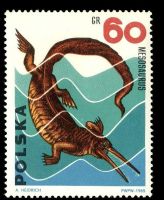 MESOSAURUS
represented on the 60 gr stamp lived in the Permian period
in the ocean of the southern hemisphere. Its body was not longer than
70 cm. It had a long beak-like mouth with a real collection of needle
sharp teeth. Owing to the long shape of its body, long tail and four
paws with 5 fingers joined by a fin-like membran it was a marvellous
swimmer and a real dread for fishes, which were its food. MESOSAURUS
represented on the 60 gr stamp lived in the Permian period
in the ocean of the southern hemisphere. Its body was not longer than
70 cm. It had a long beak-like mouth with a real collection of needle
sharp teeth. Owing to the long shape of its body, long tail and four
paws with 5 fingers joined by a fin-like membran it was a marvellous
swimmer and a real dread for fishes, which were its food. |
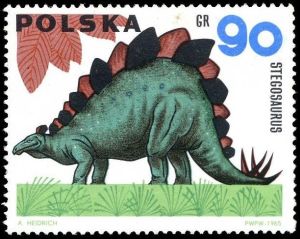 On
the 90 gr stamp we will find the Jurassie STEGOSAURUS. With
its
strong armour it is lilce a real tank among fossil reptiles. it lived
in North America, feeding itself on plants. It was not dangerous. Its 9
meter long body moved with dificulty on two pair of paws. The short
neck did not permit to reach for food placed in higher places. It was
sheltered against the danger with an armour, and had for its defense a
strong tail with prickles. On
the 90 gr stamp we will find the Jurassie STEGOSAURUS. With
its
strong armour it is lilce a real tank among fossil reptiles. it lived
in North America, feeding itself on plants. It was not dangerous. Its 9
meter long body moved with dificulty on two pair of paws. The short
neck did not permit to reach for food placed in higher places. It was
sheltered against the danger with an armour, and had for its defense a
strong tail with prickles. |
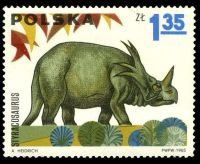 STYRACOSAURUS
represented on the 1.35 zl stamp is a dinosaur
very similar in exterior apperance to the present rhinoceres. It lived
in the Cretaceous period in North America. Its powerful head and neck
were covered with an armour and several big horns, one of them fixed on
the noce of the animal was 50 cm long. In the fight it was not be
beaten. STYRACOSAURUS
represented on the 1.35 zl stamp is a dinosaur
very similar in exterior apperance to the present rhinoceres. It lived
in the Cretaceous period in North America. Its powerful head and neck
were covered with an armour and several big horns, one of them fixed on
the noce of the animal was 50 cm long. In the fight it was not be
beaten. |
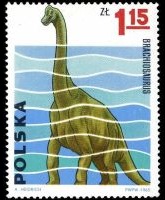 The
1.15 zl stamp represents BRACHIOSAURUS,
living
on the breach of the Jurrassic and Cretaceous periods in the waters of
America and North Africa. This reptile with a smali head and long neck
had a powerful body on four strong legs and a very strong tail.
Measurements of the body: from head to tail 22 meter, neck 9 m, height
12 m. It lived on the land as well as under the water. (*) The
1.15 zl stamp represents BRACHIOSAURUS,
living
on the breach of the Jurrassic and Cretaceous periods in the waters of
America and North Africa. This reptile with a smali head and long neck
had a powerful body on four strong legs and a very strong tail.
Measurements of the body: from head to tail 22 meter, neck 9 m, height
12 m. It lived on the land as well as under the water. (*) |
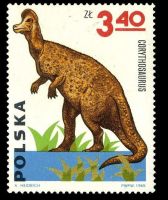 CORYTHOSAURUS
represented on the 3.40 zl stamp is a
dinosaur looking like a kangaroo. The 10 m long body moved on a
strongly developed pair of hinder legs and a long tail. The front legs
were very weak. It lived in the Cretaceous period on territories rich
in water and plants, probably on the entire globe. CORYTHOSAURUS
represented on the 3.40 zl stamp is a
dinosaur looking like a kangaroo. The 10 m long body moved on a
strongly developed pair of hinder legs and a long tail. The front legs
were very weak. It lived in the Cretaceous period on territories rich
in water and plants, probably on the entire globe. |
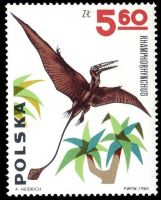 RHAMPHORHYNCHUS
represented on the 5.60 zl stamp lived in the Jurassic
period. The skeleton of this strange flying reptile was found in the
Jurassic beds in Bavaria (Germany) and some remnants in
Africa. The span of the "wings" was 80 cm. The long beak-mouth was
strongly teethed. Fishes and insects were its food. A specific
chararoteristic of this animal was its long tail facilitating steerage
in plunging and flying. RHAMPHORHYNCHUS
represented on the 5.60 zl stamp lived in the Jurassic
period. The skeleton of this strange flying reptile was found in the
Jurassic beds in Bavaria (Germany) and some remnants in
Africa. The span of the "wings" was 80 cm. The long beak-mouth was
strongly teethed. Fishes and insects were its food. A specific
chararoteristic of this animal was its long tail facilitating steerage
in plunging and flying. |
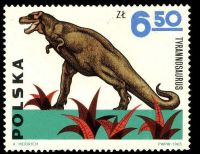 The
last stamp of the set for 6.50 zl represents a
predaceous TYRANNOSAURUS,
14 m long and 5 m tall, living in
the Cretaceous period. Its mouth 1 m long with powerful jaws and sharp
strong teeth are the best proof of its carnivorous mode of life. Its
strong hind lega and a long tail supported the big heavy body of the
monster. The pair of undevelopecl front legs was without significance.
It hunted even the biggest dinosaurus. . The
last stamp of the set for 6.50 zl represents a
predaceous TYRANNOSAURUS,
14 m long and 5 m tall, living in
the Cretaceous period. Its mouth 1 m long with powerful jaws and sharp
strong teeth are the best proof of its carnivorous mode of life. Its
strong hind lega and a long tail supported the big heavy body of the
monster. The pair of undevelopecl front legs was without significance.
It hunted even the biggest dinosaurus. . |
The text above is original stamp
description from 1965, might be obsolete.
Products
| FDC |
|
|
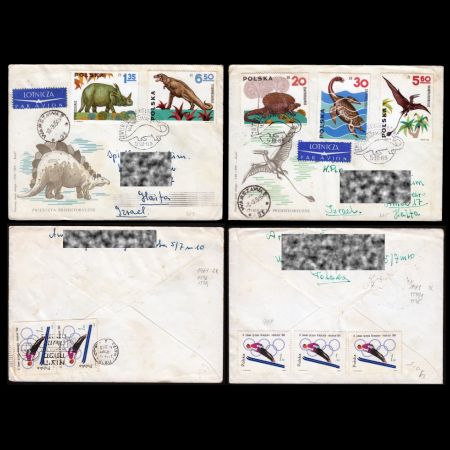 |
| Mini
Sheet |
Used
covers |
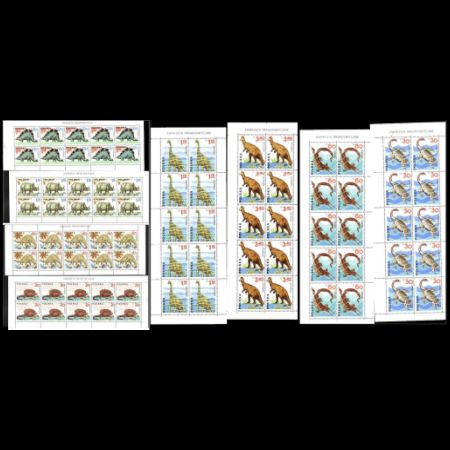 |
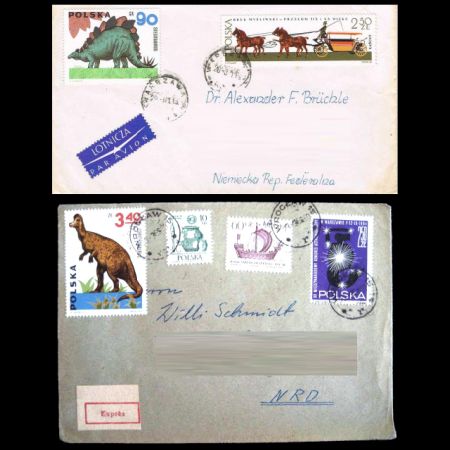 |
|
|
|
|
Acknowledgement
Many thanks to Katarzyna Gonet from Poland , for her help to find an information about these stamps
References
Filatelista Magazin Nr 1(220) dual language magazin:Polnish/English.














